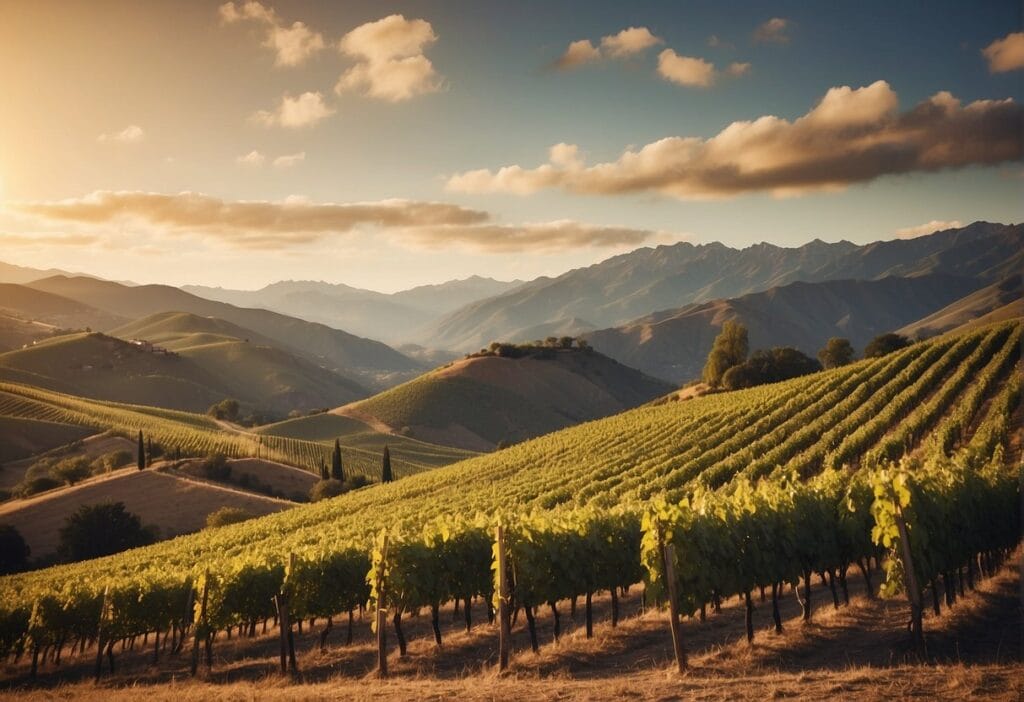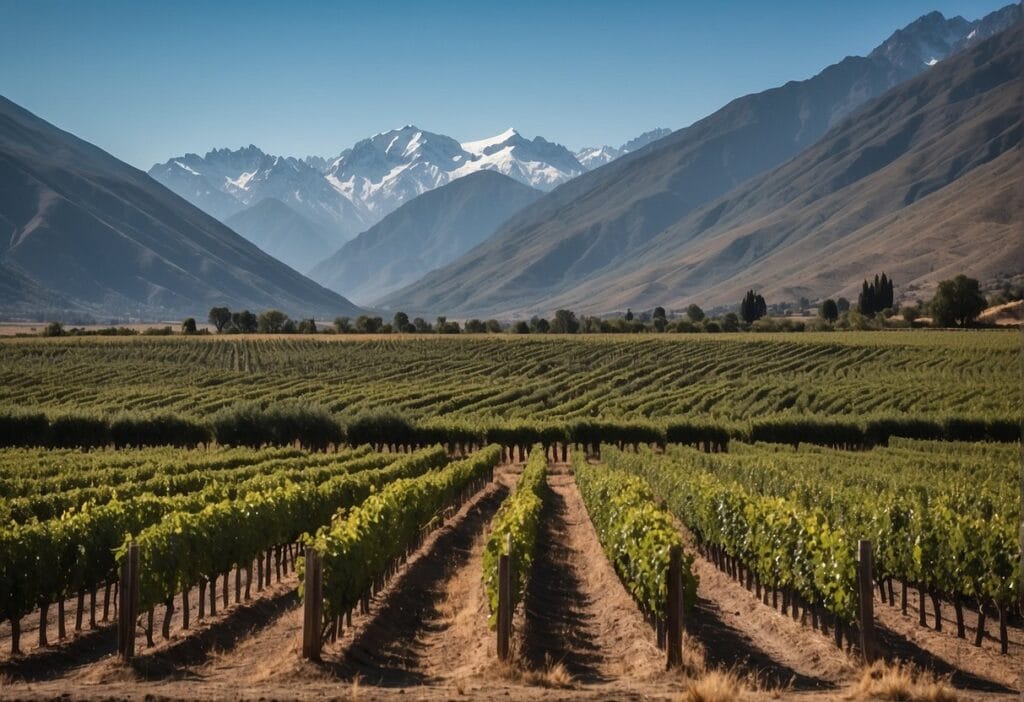Germany boasts a rich tapestry of wine regions, each with unique characteristics that contribute to the diverse range of German wines.
From the steep terraces of the Mosel to the sun-kissed hills of Baden, the geography of these regions plays a crucial role in the cultivation of grapes and the distinctive profiles of the wines produced.
As you explore these wine regions, you’ll encounter a multitude of grape varieties. Each is selected for its ability to thrive in the local climate and soil conditions.
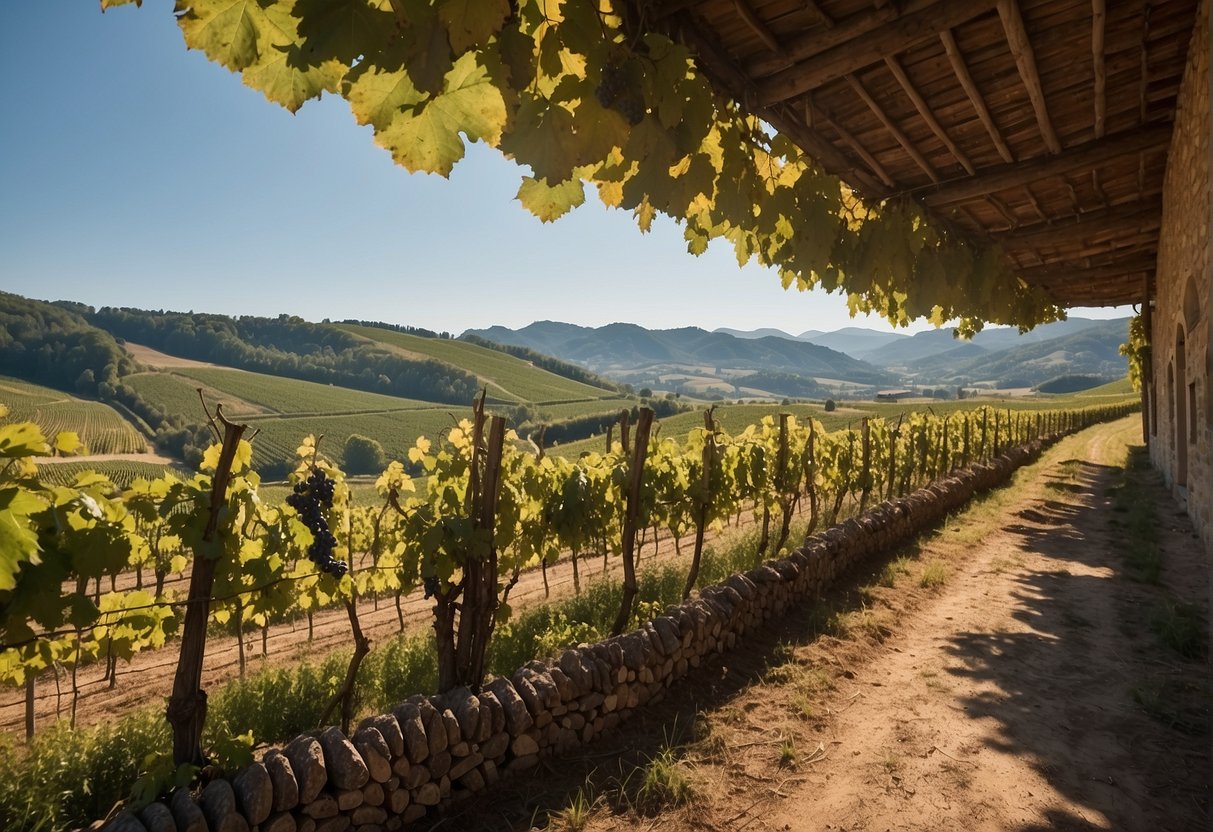
The history of winemaking in Germany is as complex and nuanced as the wines themselves. Rooted in traditions that date back to Roman times, German winemakers have developed a deep understanding of their craft, influenced by the unique geography of their land.
Today, German wines are classified according to a meticulous system that reflects the quality and specificity of each region.
Whether you’re enjoying a glass of Riesling from the Mosel or a Spätburgunder (Pinot Noir) from Baden, your experience is enriched by the cultural significance wine holds within German society.
Key Takeaways
- Germany’s wine regions offer a distinctive array of grape varieties influenced by their geography.
- The country’s winemaking history is interwoven with the development of a detailed classification system.
- German wines are central to the cultural and culinary traditions of the regions in which they are produced.
History of German Winemaking
Your journey through the history of German winemaking will reveal a tradition steeped in ancient practices and significant cultural influences.
You’ll discover the regions that set the stage for winemaking and how the Romans and the Middle Ages shaped the wine culture you know today.
Historical Wine Regions
German winemaking boasts a rich legacy dating back to the Roman Empire, when vines were first cultivated in the fertile river valleys.
The Romans recognized the potential of areas along the Rhine, Danube, and Mosel rivers, initiating a tradition that would last for millennia.
During the Middle Ages, this tradition was nurtured and refined, with monasteries and churches becoming central to the development of winemaking techniques and regional specializations.
In particular, regions such as Rheingau and Mosel were recognized for their quality production. They benefited from the Roman influences and the subsequent care taken by religious institutions.
The precise locations where vineyards were established by the Romans are now treasured for their historical significance and the continuity of viticulture.
Influence on Wine Culture
The Middle Ages were pivotal in shaping your contemporary wine culture, with Charlemagne notably influencing viticulture laws and practices.
It was in this era that German wine started to build its repute for quality. The 8th century marked the spread of viticulture into areas like Rheingau, influenced by ecclesiastical and royal decree, setting the foundations for renowned wine-making practices that prioritized both the spiritual and economic value of wine.
More than just an agrarian pursuit, wine became an integral part of societal norms and customs. The cultivation methods and the communal aspects of wine drinking emphasized during these times are intrinsic to the cultural identity of German wine regions, a legacy that exists to this very day.
Geography of German Wine Regions
Germany’s wine regions boast diverse geography that greatly influences the character of its wines.
River Valleys and Wine
The Rhine river and its tributaries, such as the Mosel, Nahe, and Rheingau, provide excellent conditions for vineyards.
These rivers create narrow, steep valleys that expose vines to more sunlight, which is crucial in a cooler climate like Germany’s.
The Mosel valley, in particular, is famous for its steep slopes which create some of the world’s most prized white wines, with Riesling leading the pack.
Climate and Soil
The climates of German wine regions vary, but they are generally categorized as cool, influenced heavily by the country’s southwestern and southern locations.
For example, the Pfalz (or Palatinate) region enjoys a warmer climate due to its sheltered position by the Haardt mountains.
Soil types across Germany’s wine regions are also diverse. The Rheinhessen area contains a rich mixture of loess and limestone, while Franken is known for its mineral-rich gypsum keuper.
These soil varieties contribute to the distinctive flavors of German wines, from the mineral notes in a Riesling to the earthy tones in a Spätburgunder.
Major Wine Regions and Their Characteristics

Germany’s wine regions offer a rich tapestry of flavors and traditions, each with their own unique characteristics. Whether you’re a seasoned connoisseur or just beginning your wine journey, these regions have something to entice your palate.
Ahr: As one of the smallest wine regions, Ahr is renowned for its exquisite red wines, especially Spätburgunder (Pinot Noir). The steep, terraced vineyards here produce wines with depth and complexity.
Baden: Germany’s southernmost wine region, Baden, enjoys a warm climate that favors a variety of grape types. This region is perfect if you’re keen on full-bodied white wines and the ever-so-charming Spätburgunder.
Franconia: Best known for its distinctive bottle shape called Bocksbeutel, Franconia primarily features mineral-rich white wines made from the Silvaner grape.
Mittelrhein: Home to dramatic landscapes, the vineyards nestled along the Rhine river yield exceptional Riesling wines, celebrated for their expressiveness and minerality.
Mosel: Famous for its steep slopes and slate soil, Mosel’s Riesling is unparalleled, offering a perfect balance between acidity and sweetness, with a lightness that belies its structure.
Palatinate (Pfalz): With the Haardt mountains sheltering the region’s extensive vineyards, Palatinate indulges you with some of Germany’s most well-regarded Rieslings and a host of other grape varieties.
Sachsen (Saxony): This eastern wine region is notable for its picturesque landscapes and historic vineyards that focus on crafting both white and red wines that mirror its unique terroir.
Coupling these descriptions with an exploration on the ground, or in a glass, will offer you a memorable taste of Germany’s wine heritage. Enjoy discovering the diverse and delectable flavors these regions provide.
Mosel (Mosel-Saar-Ruwer)
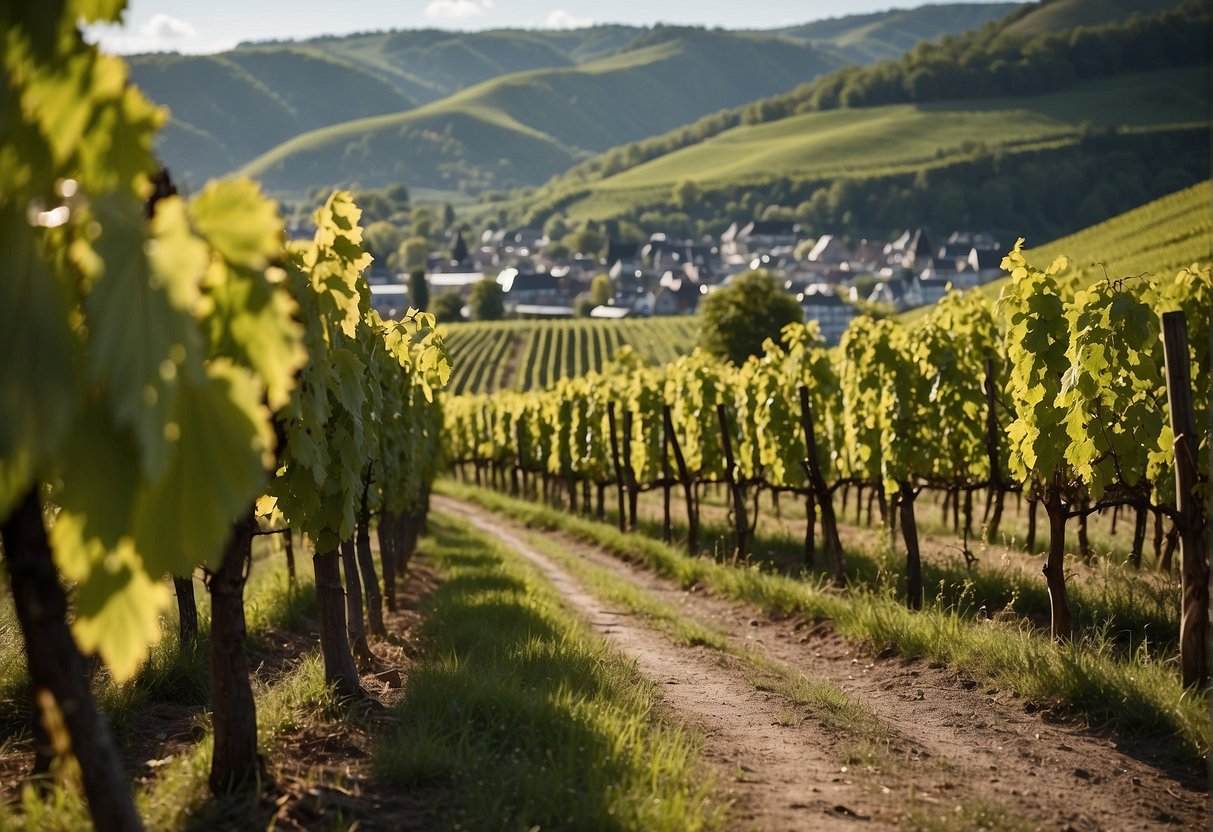
The Mosel region, with its picturesque terraced vineyards and historic influence, is Germany’s oldest wine-producing area. Recognized for its premium Riesling wines, the Mosel River’s twists and turns create an ideal microclimate for viticulture.
Your journey through this wine region wouldn’t be complete without understanding the significance of its unique terroir.
Characterized by steep slopes, the vineyards benefit from the river’s reflection which aids in ripening the grapes. This is where the magic happens, and the cool climate becomes an advantage, intensifying the aromatics and preserving the grapes’ natural acidity.
Here’s what makes this region exceptional:
- Age-worthy Rieslings: Wines from Mosel are known for their ability to develop complexity over years.
- Cool Climate: Enhances the nuanced flavors and maintains a balance of sugar and acidity.
- Steep Slopes: They laboriously capture more sunlight, contributing to the grapes’ ripening process.
When you explore Mosel wines, pay attention to characteristics like the floral and mineral notes typical of the Rieslings from this region.
You’ll likely discover undertones of green apple, peach, and sometimes even tropical fruits. Each glass tells the story of the terroir from which it comes.
For a deeper understanding, visit guided tours that reveal the region’s rich history and production techniques, ensuring a memorable wine experience.
Take the chance to experience the charm of the small towns and savor the fruit of meticulous German winemaking.
Check “Germany’s Oldest Wine Region” to learn more about the traditional yet cutting-edge winemaking of Mosel-Saar-Ruwer.
Rheingau and Mittelrhein
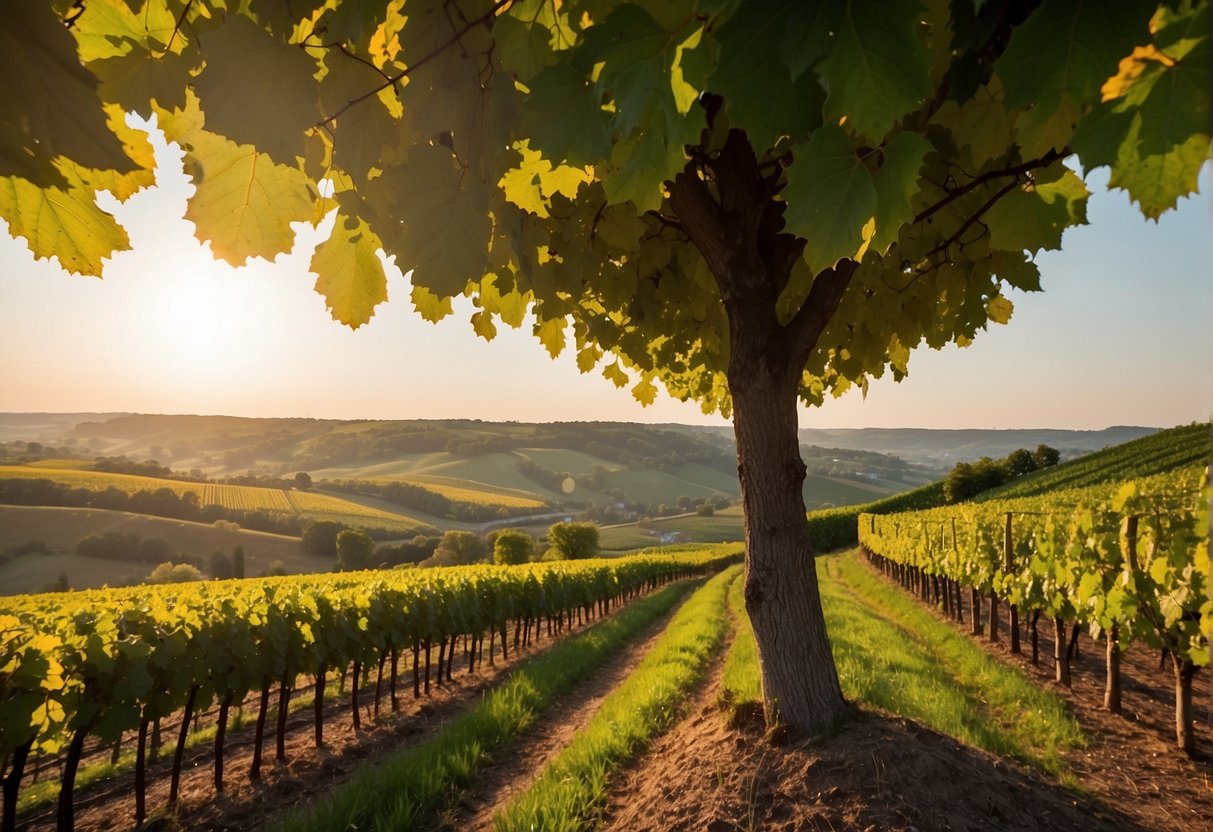
Rheingau is a renowned wine region located in Germany. You’ll find picturesque vineyards along the Rhine River. This area stretches from Wiesbaden to Rudesheim and is particularly famous for its dry Riesling wines. These wines are characterized by refreshing citrus aromas. The steep slopes along the riverbanks, such as the Rüdesheimer Berg, create an ideal microclimate for grape growing. As a result, they yield wines with a unique character.
Exploring the Rheingau wine region, you can visit multiple heritage sites. You can also delight in the scenic beauty sprinkled with rustic villages.
Moving to Mittelrhein, this wine region is nestled along a 120 km stretch of river Rhine. It is known for its dramatic landscapes and historical significance. Here, the vineyards lie on the left bank of the Rhine, beginning just downstream of the Nahe estuary and reaching all the way to Koblenz.
The region specializes in quality wines and offers a variety of wine tastings and tours. The Mittelrhein wine region is a place where you can deeply connect with Germany’s wine heritage and the tranquil beauty of the Middle Rhine.
When you’re planning your visit, you have the opportunity to indulge in experiences like wine tasting at renowned wineries, such as Weingut Kaufmann and Weingut Trenz. These wineries are selected for their exceptional practices and historical significance. Discover biodynamic vineyards and even wines that have been chosen by German Chancellors. Find insight into these experiences at winetourism.com.
Both regions offer a sense of escape into the heart of German winemaking. They invite you to immerse yourself in the rich tapestry of flavors, aromas, and timeless traditions.
Pfalz (Palatinate)
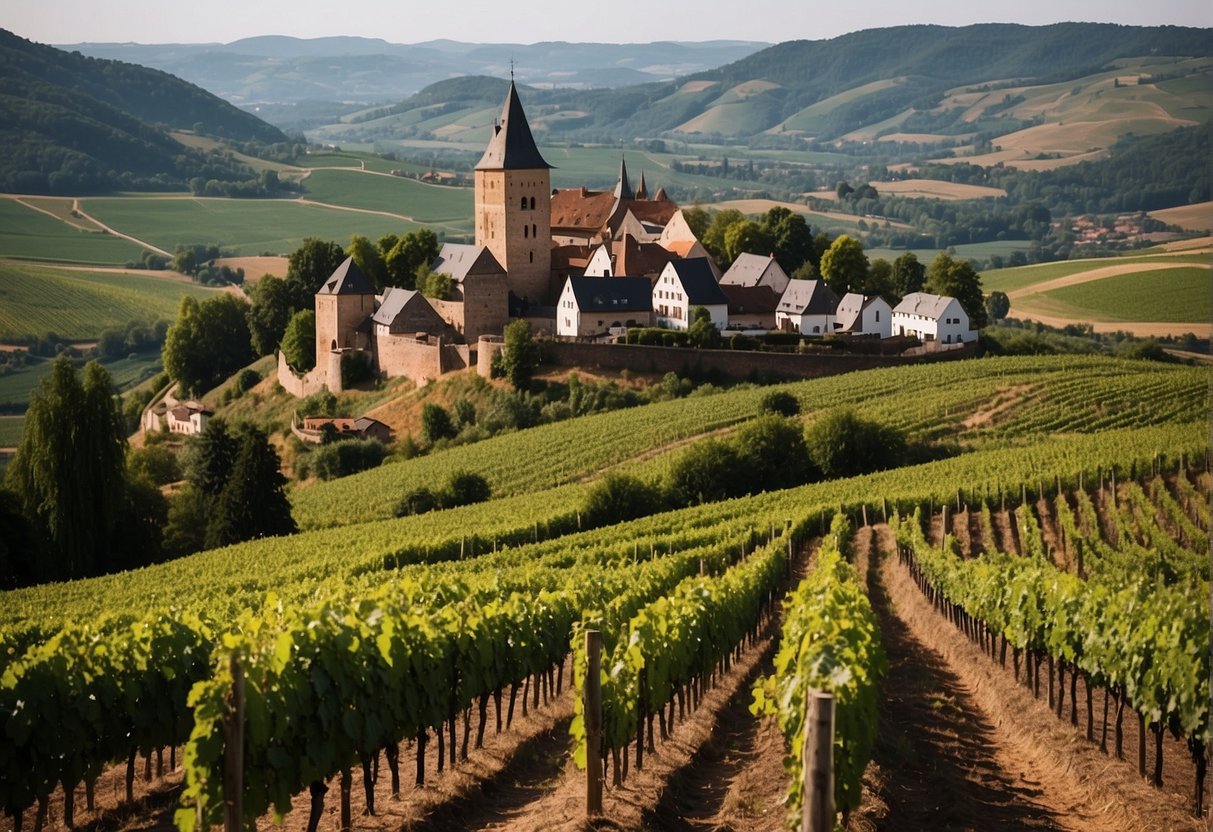
The Pfalz region, known for its picturesque landscapes and historic charm, is a prime destination for wine enthusiasts like you. Nestled in western Germany, it marks the country’s second-largest wine-producing area.
With around 23,500 hectares of vineyards, Pfalz offers a delightful exploration of Germany’s vinicultural heritage.
In this region, you’ll discover that Riesling grapes thrive, bolstering Pfalz’s reputation as a white wine haven. The ample sunlight and protective Haardt mountains create a climate favorable for these vines. You’re likely to appreciate the complex and aromatic qualities that Pfalz wines have to offer.
Red wine lovers aren’t left out either. Pfalz stakes a claim as Germany’s most abundant red wine region, with nearly 40% of its vineyards growing red grape varieties. The cultivation draws on a deep-rooted tradition that many local families have sustained over generations.
When you visit Pfalz, you’re not just tasting wine; you’re immersing yourself in a culture that is deeply interconnected with the art of winemaking. The community here is proud of their contribution to Germany’s wine production, which is significant, given that the region is instrumental in producing 65 to 70% of the country’s wine grapes.
Here’s a quick glance at what Pfalz offers:
- White Wines: Primarily Riesling, with a global prominence.
- Red Wines: A leader in German red wine production.
- Geography: Between the Rhine river and the Haardt mountains.
- Climate: Ideal for diverse grape varieties.
Baden and Württemberg
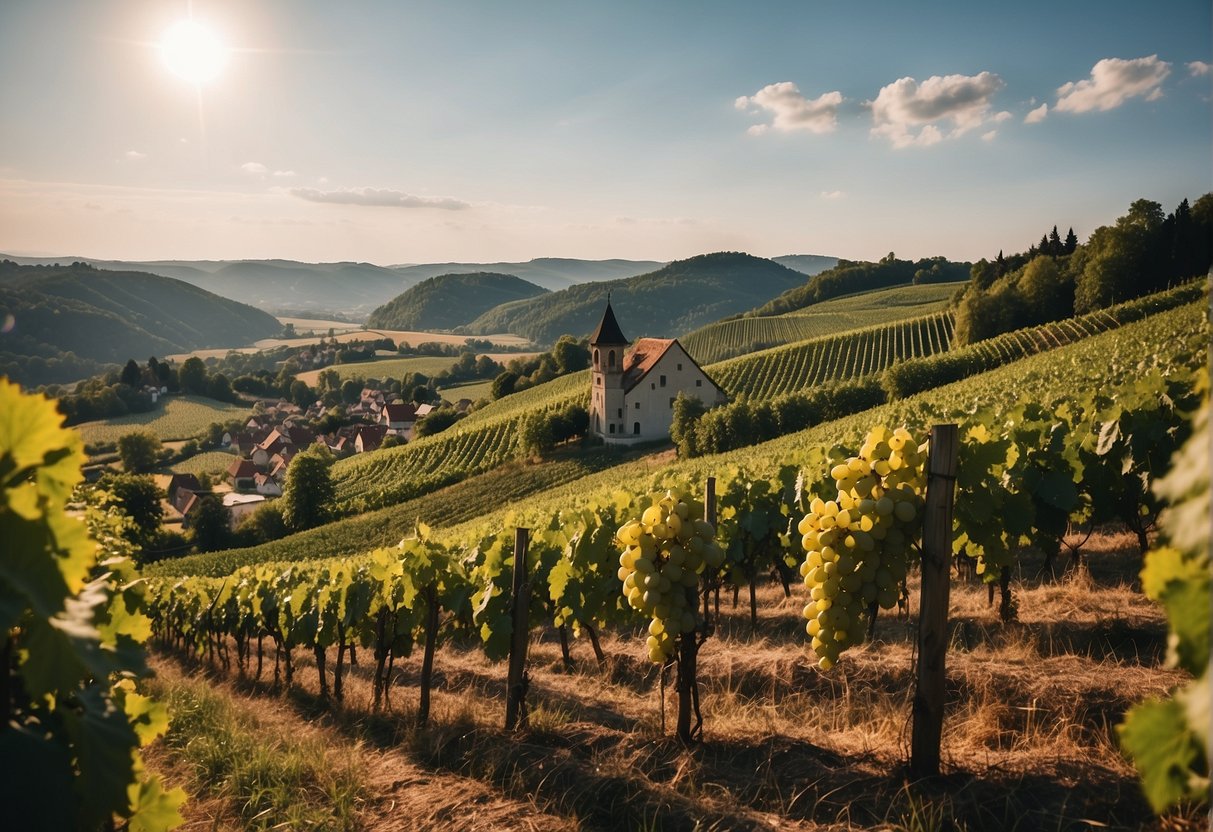
In Germany, Baden and Württemberg are two prominent wine regions known for their unique offerings.
Baden is celebrated for its quality wines, located in southwestern Germany within the historical region of Baden. Here, the vines bask in a climate favored by the proximity to the Rhine River, which contributes to the region’s warmer temperatures. This allows for the flourishing of a wide range of grape varieties, notably the Spätburgunder (Pinot Noir).
| Baden’s Highlights |
|---|
| Climate: Warm, similar to the Mediterranean |
| Famous for: Spätburgunder (Pinot Noir) |
| Geography: Nestled next to the Rhine River |
Württemberg, on the other hand, stands out as Germany’s premier red wine region with a predominance of red grape varieties. It’s located around the Neckar River and its tributaries. This area is characterized by numerous south-facing slopes, which give the grapes optimal sun exposure. Württemberg is often associated with the Trollinger grape, which produces a light red wine that’s a local favorite.
| Württemberg’s Highlights |
|---|
| Climate: Diverse, influenced by river valleys |
| Famous for: Trollinger, Lemberger, and Riesling |
| Geography: Hilly terrains and river valleys |
When you explore these regions, you’ll notice an authentic charm, where family-owned wineries pass down their winemaking traditions through generations. In Württemberg especially, many vineyards not only create wines with love but also with a dash of creativity, often giving their barrels playful names.
Franken (Franconia)
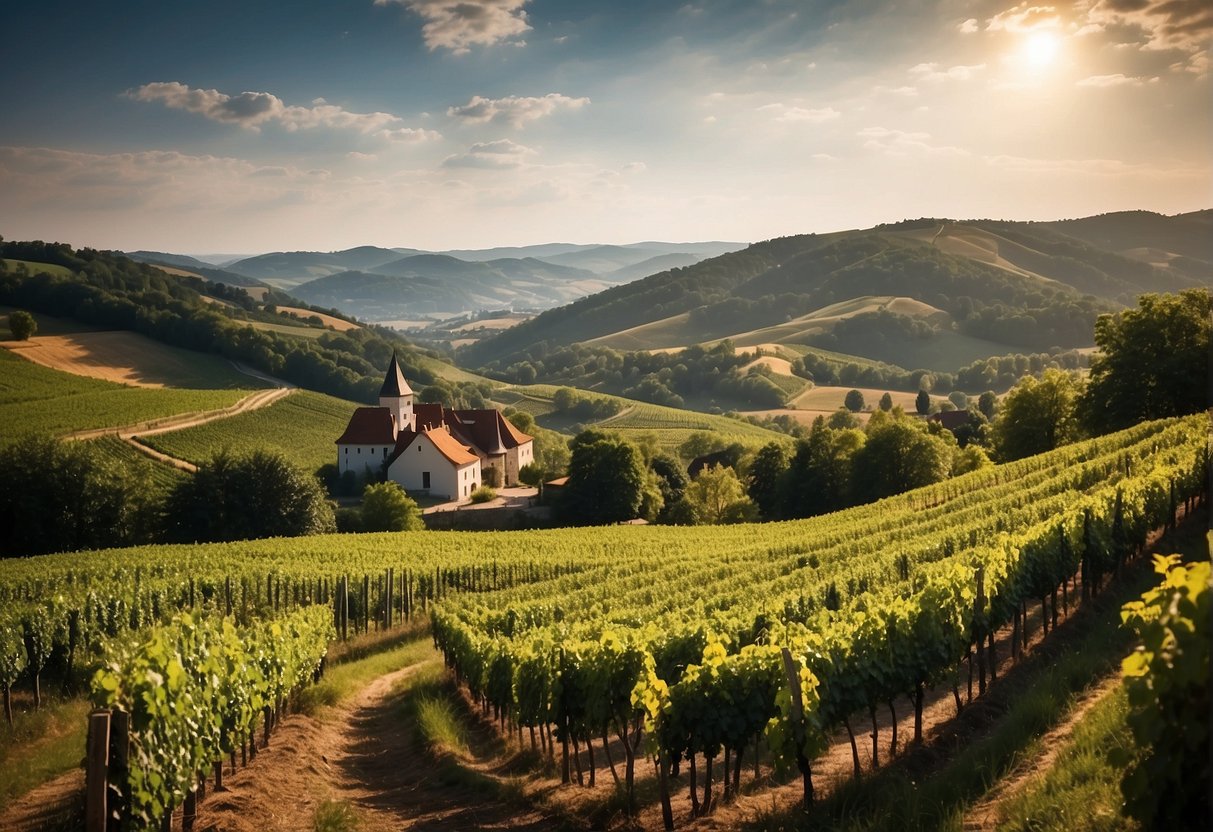
In the heart of Bavaria, you’ll find Franken, a wine region celebrated for its distinctive wines and rich viticultural history. Unlike Bavaria’s iconic beer culture, Franken offers a refreshing spin on German enology, focusing on white grape varieties which cover 80% of its vineyards.
You’ll be intrigued by the region’s unique wine bottle, the Bocksbeutel, a tradition that goes beyond aesthetics; it represents the heritage of Franconian wine. The landscape here, rippling with hills and nourished by the Main River, provides a picturesque backdrop for over 6,000 hectares of vineyards. Each vineyard nurtures a range of grape varieties like the Silvaner and Müller-Thurgau, creating wines with a reputation for quality and distinct character.
Winemaking in Franken has evolved with time, seamlessly integrating modern techniques while honoring centuries-old traditions. Your experience here isn’t just about tasting wine; it’s a deep dive into Franconia’s culture and traditions. It’s a chance to grasp what it means to cherish vineyards that are as much a part of local identity as the dialect or cuisine.
Embrace your wine journey in Franken with a visit to local wineries or by indulging in a glass of white wine that captures the essence of this unique German wine region. Your palate will thank you for the opportunity to savor flavors that are as memorable as they are elegant.
- Wine Bottle: Bocksbeutel
- Primary Focus: White Wines
- Key Grape Varieties: Silvaner, Müller-Thurgau
- Region Size: >6,000 hectares
- Cultural Identity: Rich history integrated with modern innovation
Sachsen (Saxony) and Saale-Unstrut

When you’re exploring the diverse world of German wines, the regions of Sachsen and Saale-Unstrut stand out due to their unique locations and wine profiles.
Sachsen, often known as Saxony, situates itself as one of the world’s northernmost wine regions. Your experience with Saxony wines centers around the picturesque Elbe River Valley. Here, the vines stretch along a 40km area, in a northeastern direction from Pillnitz, near Dresden, to Diesbar-Seusslitz, near Meissen (Wine-Searcher: Sachsen).
It’s a region marked by its distinctive continental climate, giving you a variety of wines predominantly from white grape varieties.
- Popular Grapes: Müller-Thurgau, Riesling
- Climate: Continental
- Wine Styles: Mainly whites, light-bodied, and aromatic
Moving a bit to the west, you’ll find Saale-Unstrut, one of the most intriguing wine-growing areas. Named after the Saale and Unstrut rivers, and famed as the northernmost quality wine region in Germany, Saale-Unstrut offers you rolling hills and wine steeped in history (Wikipedia: Saale-Unstrut).
With around 650 hectares of vineyards, your exploration into Saale-Unstrut wines reveals a tradition that goes back to the 11th century.
Ahr and Nahe
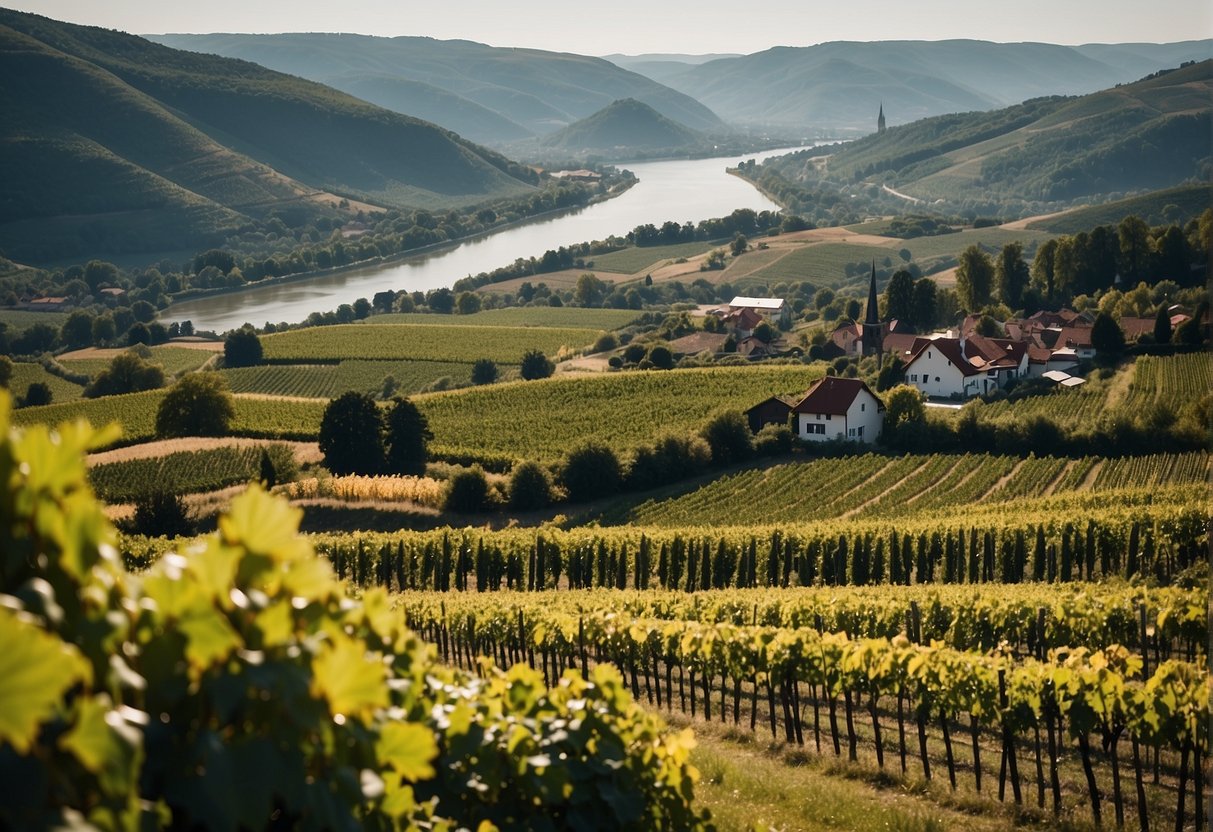
When you explore the wine regions of Germany, you’ll find that both Ahr and Nahe feature unique characteristics that make them stand out.
The Ahr wine region is renowned for its red wines, especially the Pinot Noir. It’s one of the smaller regions, but it boasts a high quality of wine that reflects the valley’s terroir. The landscape of vineyards rolling along the Ahr River gives this region a picturesque backdrop. With its relatively northern location, it defies the expectation as a red wine haven in a country known for whites.
- Location: Rhineland-Palatinate
- Known for: Pinot Noir
- Vineyard Area: Approximately 558 hectares
Moving over to Nahe, this region presents a contrasting wine experience. White wines, particularly Riesling, dominate here, making up 75% of the planted grapes. You can expect to taste crisp, mineral-driven wines that showcase the diverse soils of the region. With over 4,000 hectares of vineyards, Nahe provides a broad palette of flavors for every wine enthusiast.
- Location: Rhineland-Palatinate
- Dominant Grape: Riesling
- Vineyard Area: Over 4,155 hectares
In both areas, you can tour the vineyards, meet the winemakers, and enjoy tastings that will broaden your appreciation for Germany’s vinicultural diversity. Whether you favor the robust reds of Ahr or the delicate whites of Nahe, these regions promise a friendly welcome to the world of German wines.
German Wine Classification
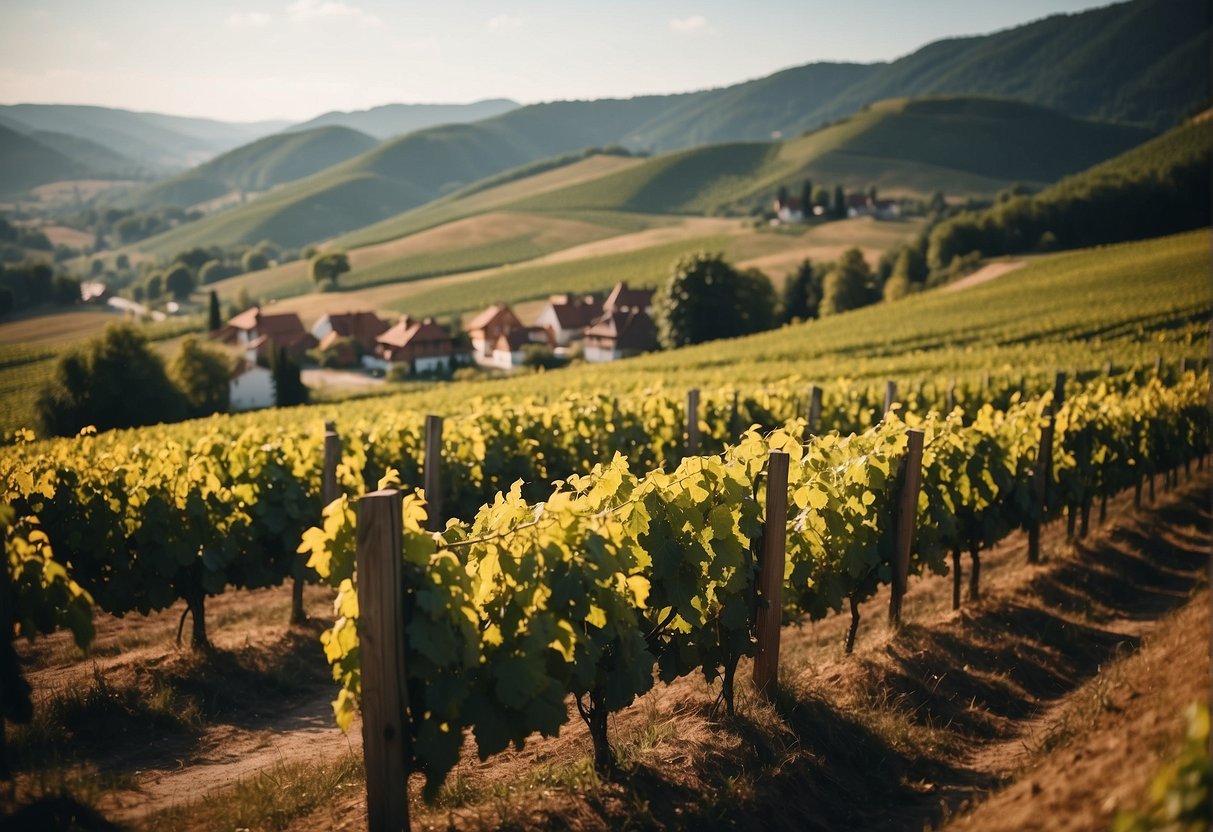
When you explore the wine regions of Germany, understanding the classification system is key to selecting quality wines. This system helps you navigate through the complexity and sweetness levels of German wines, from the everyday table wine to the most exquisite selections.
Prädikatswein and Quality Designations
Prädikatswein represents the pinnacle of German wine quality, with categories that signify the ripeness and quality of grapes at the time of harvest. This classification includes:
- Kabinett: Typically light, with a balance of sweetness and acidity.
- Spätlese: Meaning ‘late harvest’, these wines are richer and can range from dry to sweet.
- Auslese: Selected ripe bunches lead to even fuller-bodied wines, often sweet or dessert-style wines.
- Beerenauslese (BA): Made from individually hand-selected overripe grapes, often affected by noble rot, resulting in highly concentrated sweet wines.
- Trockenbeerenauslese (TBA): These are made from grapes shriveled to raisins, yielding incredibly sweet, honey-like wines.
- Eiswein: Harvested and pressed while frozen, resulting in a concentrated, sweet wine with high acidity.
These wines can be either dry (trocken) or sweet, depending on the winemaking process.
VDP Classification System
The VDP (Verband Deutscher Prädikatswein) has its own prestigious classification system, which focuses on the origin of the wine, signifying the terroir and the winemaker’s commitment to quality. It is akin to the French appellation system and uses the following terms:
- VDP.Grosse Lage: This denotes wines from the highest quality vineyards with distinctive characteristics.
- VDP.Erste Lage: Represents first-class vineyards with excellent growing conditions.
- VDP.Ortswein: Wines that express the characteristics of their town.
- VDP.Gutswein: Good quality, entry-level wines from a VDP estate.
Landwein and Qualitätswein
Beneath Prädikatswein, you encounter Landwein, which is somewhat like the French Vin de Pays, signifying a step up from table wine with a geographical indication. It’s typically a simple, everyday wine.
Qualitätswein, or quality wine from a specific region (QbA), ensures that the wine comes from one of the 13 designated quality wine regions of Germany and meets higher production standards than table wine. These wines can range from dry to sweet and often indicate the grape variety and region on the label, allowing you to better understand the wine’s character.
Grape Varieties and Wine Styles
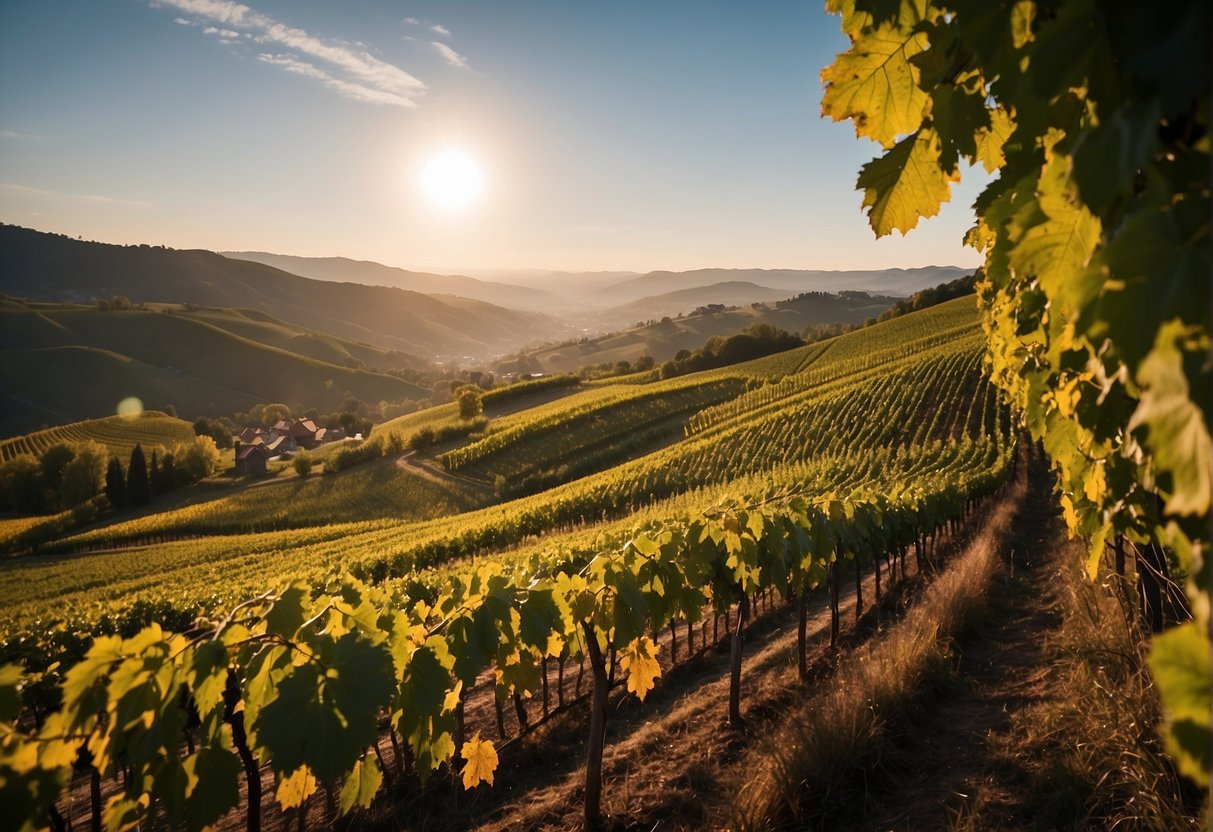
Germany’s wine regions excel in both white and red grape varieties, leading to a multifaceted range of wine styles. You’ll discover an array of flavors from the crisp acidity of Riesling to the rich notes of Dornfelder reds.
White Grape Varieties
When you think of German white wines, the Riesling grape is probably the first that comes to mind. Renowned for its crisp acidity and vibrant fruity flavors, it is a hallmark of German viticulture. Other prominent white varieties include Müller-Thurgau, known for its easy-drinking style, and Silvaner, offering more subtle and earthy tones.
- Riesling: Delivers a dynamic range from dry to sweet, always with a fresh acidity.
- Silvaner: Tends towards the drier, more mineral spectrum of white wines.
- Müller-Thurgau: Often exhibits floral aromas and a softer palate.
Germany also produces respected Pinot Gris and Chardonnay, both with their own unique expressions in this cool climate.
Red Grape Varieties
German red wines, once overshadowed, have risen in popularity. Varieties such as Dornfelder, showcasing deep color and berry flavors, and Lemberger (also known as Blaufränkisch), with its spicy notes, are gaining acclaim.
- Dornfelder: Bold and fruity, with a slightly off-dry to sweet profile.
- Trollinger: Light-bodied with a distinctive freshness.
- Portugieser: Typically produces wines that are smooth and approachable.
Additionally, Schwarzriesling (Pinot Meunier) creates lighter red wines often characterized by their bright, red-fruit flavors and soft tannins.
Notable Wine Styles
Apart from the individual grape varieties, the style of German wines can vary greatly:
- Dry and off-dry whites balancing acidity with fruitiness, such as classic dry Rieslings.
- Rich and intense reds, like those made from Dornfelder, suitably introducing a hint of oak and deeper flavors.
Viticulture and Winemaking
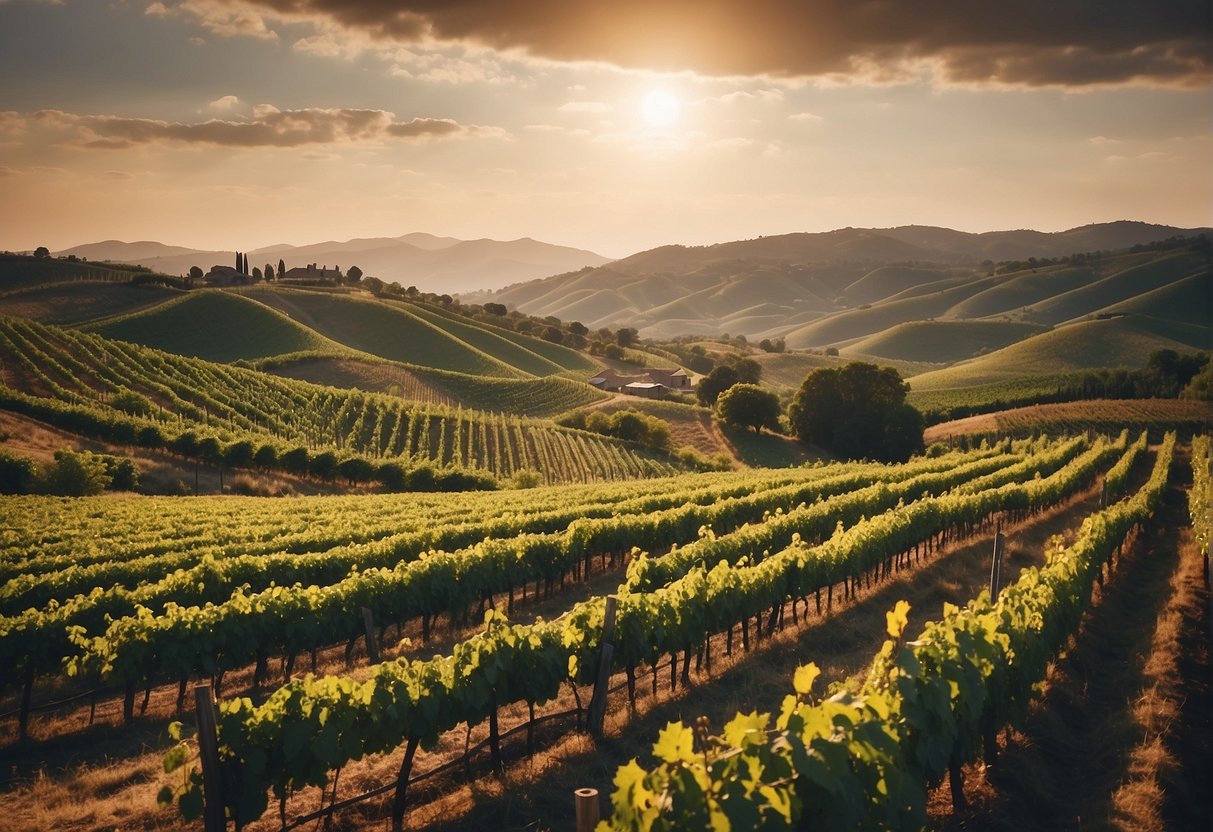
In the heart of Europe, you’ll find German wine regions renowned for their meticulous vineyard care and innovative winemaking practices. These contribute significantly to the distinctive quality and character of German wines.
Winegrowing Techniques
In German vineyards, growers use sustainable winegrowing techniques to maintain the health of the soil and vines. Precision and a gentle touch define the approach to viticulture. For instance, in the terraced vineyards along the Mosel river, meticulous canopy management ensures that each grape receives just the right amount of sunlight, enhancing the grapes’ flavor profile.
Harvest and Production
Harvest is a crucial time for German winemakers, as they decide the perfect moment to pick the grapes, which can influence the sweetness, acidity, and overall balance of the wine. During production, traditional methods like spontaneous fermentation, where the natural yeasts on the grape skins are used to start fermentation, are still in practice and contribute to the complexity of the wines.
Innovation in Winemaking
A spirit of innovation thrives among German winemakers. They continually develop new winemaking techniques, such as implementing gravity flow systems in cellars to gently handle grapes and wine. This innovative mindset is part of the reason why German wines often stand out on the world stage for their quality and uniqueness.
Culinary Traditions and Wine Pairing
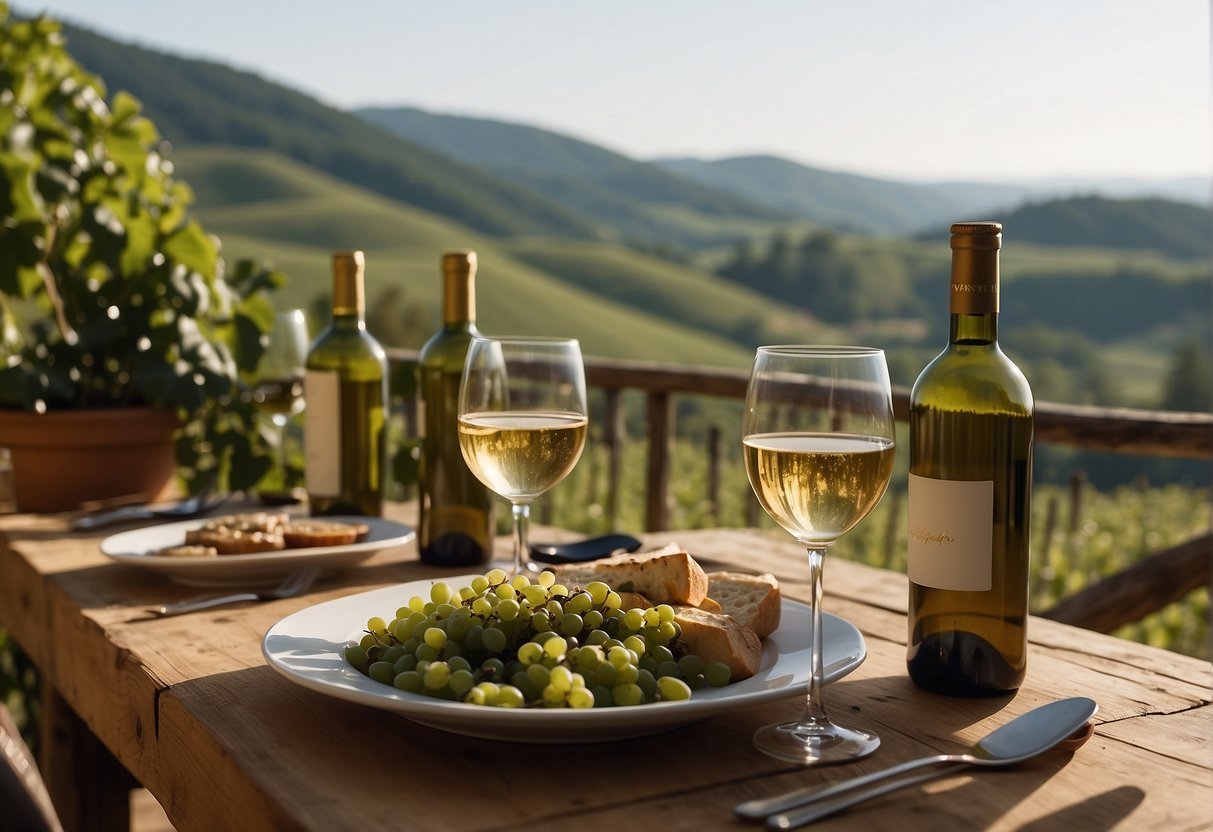
When you think of German culinary traditions, images of hearty meals may come to mind. Wine pairing in Germany isn’t just an art form; it’s a complementary dance between the rich flavors of the cuisine and the diverse wines produced within the country’s various regions.
German Cuisine and Wine
German food is characterized by its robust flavors and comforting textures. You’ll find that many traditional dishes are a seamless match with the country’s equally diverse range of wines:
- Sauerbraten: A tangy marinated beef dish best enjoyed with a glass of the light and fruity Spätburgunder, analogous to Pinot Noir, which can gracefully cut through the richness of the meat.
- Bratwurst and Sauerkraut: Here, a slightly spicy Riesling works wonders, offering a balance to the dish with its crisp acidity and stone fruit notes.
- Weisswurst and Brezeln with Obatzda: A Bavarian classic that pairs delightfully with a refreshing and zesty Weißburgunder or Pinot Blanc.
- For a northern twist, dishes featuring herring or Alaskan pollock are accentuated by a light white wine with bright acidity, such as a Müller-Thurgau or Sylvaner, highlighting the region’s affinity for wines with a sharp, minerality edge that echoes the sea.
Wine Pairing Principles
When diving into the principles of wine pairing, you’ll benefit from knowing that balance is key:
- Contrast flavor profiles: Match the intensity of the food with the wine. A bold German Schweinshaxe (pork knuckle) might stand up nicely against an equally strong Dornfelder.
- Match acidity levels: German cuisine often incorporates vinegar and citrus, so look for wines that share a similar acidity, such as a dry Riesling or Scheurebe.
- Consider the preparation method: A smoked German fish pairs well with an aromatic Gewürztraminer. Here, the smoky flavors are complemented by the wine’s bold lychee and rose petal notes.
Cultural Significance of Wine in Germany
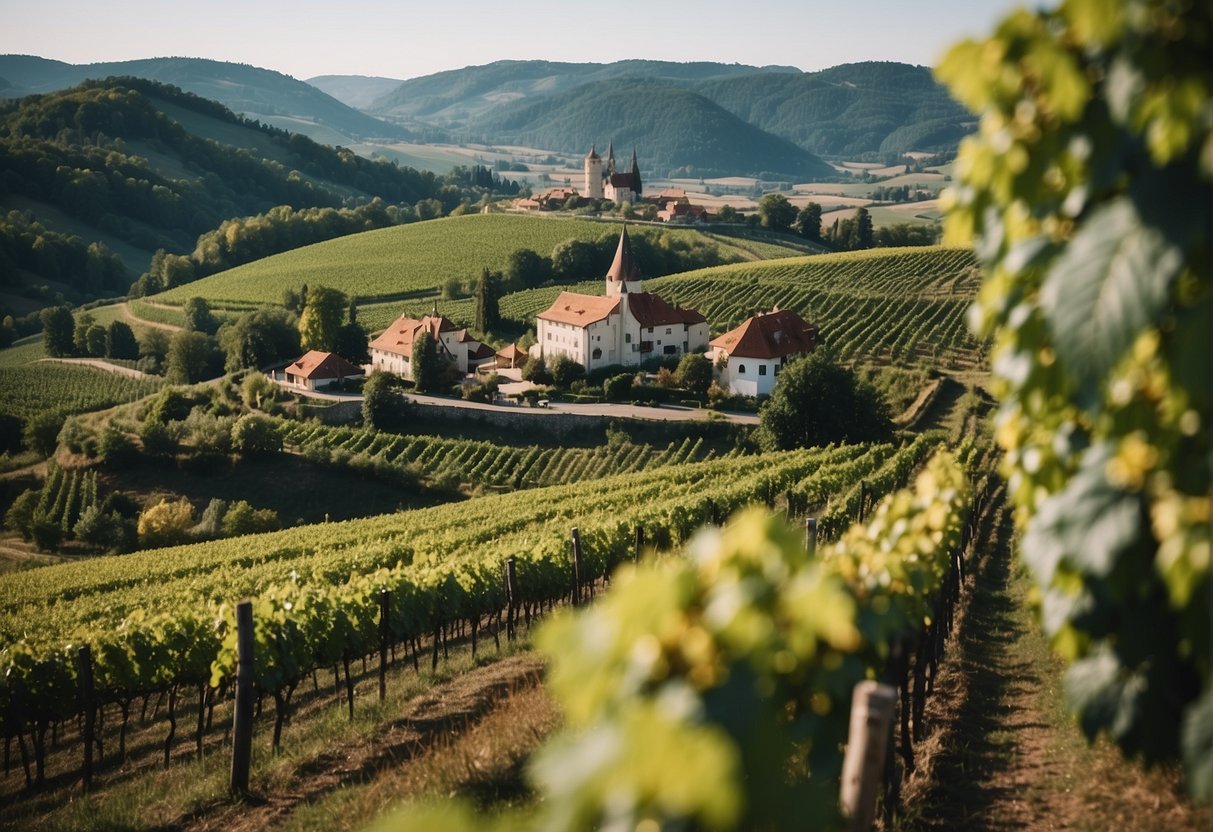
Wine in Germany is more than just a beverage; it’s an integral part of the nation’s culture, celebrated through numerous wine festivals and wine tourism activities. You’ll find that each glass carries a story of local tradition and communal pride.
Wine Festivals and Public Events
Each year, you can immerse yourself in German tradition by attending various wine festivals throughout the country. These events, like the famous Rheingau Wine Festival, offer a rich fusion of local food, live music, and, of course, exquisite wines. They provide a taste of the German way of life where the community gathers to celebrate their vinicultural achievements and heritage.
As you walk through one of these vibrant festivals, notice how the air buzzes with the shared joy of producers and connoisseurs alike.
Wine Tourism and Routes
For wine enthusiasts like you, wine tourism offers a captivating journey through scenic vineyards along the German Wine Route. This route, established in 1935, lets you explore the heart of wine country, from the Palatinate region to the picturesque villages of Rheinhessen.
While traveling these routes, don’t miss the chance to visit local wineries. There, you can experience intimate tastings and learn about wine-making straight from the vintners.
Wine tourism in Germany isn’t just about the drink; it’s an adventurous exploration of culture, cuisine, and breathtaking landscapes.
Conservation and Sustainability
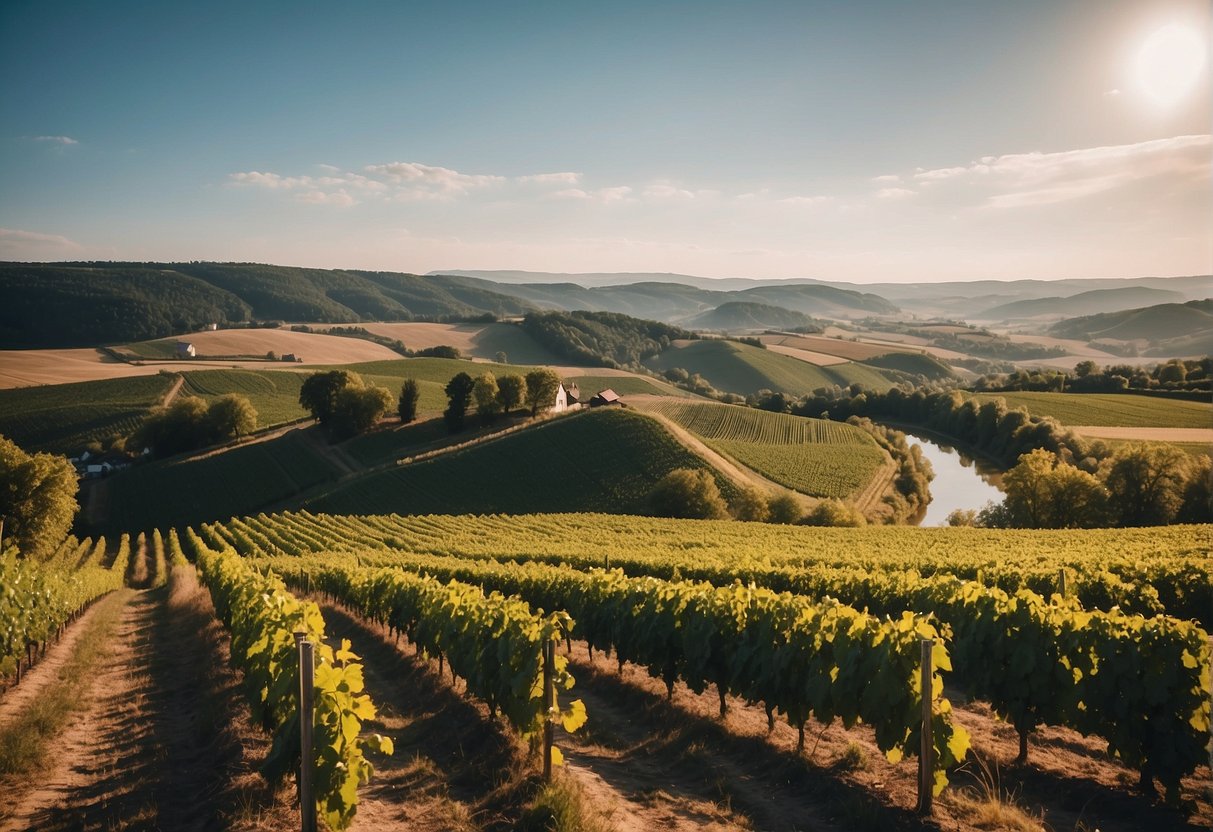
When you think about German wine regions, consider how deeply they are rooted in both conservation and sustainability practices. These efforts ensure you can enjoy fine German wines while supporting environmentally friendly initiatives.
Environmental Initiatives
German wine regions are actively pursuing various environmental initiatives to reduce their carbon footprint and protect the local biodiversity.
One example is the Ahr wine-growing region, which, despite being one of the smallest, is intensively working on sustainable viticulture.
Similarly, initiatives across regions such as Baden focus on climate protection and enhancing the ecological balance within vineyards.
Think of it as maintaining the natural harmony of the land that is home to the vines you cherish.
Organic and Biodynamic Practices
If you prefer wines produced with minimal intervention, you’ll appreciate the organic and biodynamic methods many German vineyards are embracing.
Organic vineyards abstain from using synthetic pesticides and fertilizers, keeping your wine free from unwanted chemicals.
Meanwhile, biodynamic practices take this a step further, aligning agricultural activities with the natural rhythms of the earth and cosmos.
For you, this means enjoying wines that truly embody the essence of their natural environment.
By choosing wines from regions like the German Wine Route, you support areas recognized for their commitment to sustainable and responsible winemaking.
Frequently Asked Questions

Germany’s wine regions offer a diverse tapestry of flavors and traditions. Here, you’ll find insight into the nuances that distinguish each area, understand the grading system designating wine qualities, and discover which regions are a must-visit for any wine connoisseur.
What distinguishes the different wine regions within Germany?
Each wine region in Germany has its unique climate, soil composition, and grape varieties.
The Rheinhessen area, for instance, is known for its Riesling production, while Pfalz features a warmer climate that supports a variety of grapes.
Can you explain the wine classification system used in Germany?
Germany’s wine classification system, known as the Prädikatswein, categorizes wines based on the ripeness of the grapes at harvest time.
Wines range from Kabinett (light and delicate) to Trockenbeerenauslese (rich and sweet with concentrated flavors).
Which region in Germany is considered the top destination for wine enthusiasts?
The Mosel region, with its steep slopes and slate soils, is highly regarded and often considered the top destination for wine enthusiasts. It’s celebrated for producing some of the world’s finest Riesling wines.
How do the wine label terms in Germany indicate the quality and origin of the wine?
Wine labels in Germany reveal a lot about the wine through terms like “Qualitätswein” which ensures the wine is from a specific region and meets quality standards.
“VDP.Grosse Lage” denotes wines from Germany’s highest quality vineyards.
What are the characteristics of wines produced in the Baden and Ahr regions of Germany?
Baden is known for its full-bodied and rich Pinot Noir (Spätburgunder), while the Ahr region, despite its small size, also specializes in elegant Pinot Noir wines that reflect the terroir’s volcanic origins.
Are there unique types of wine that are specifically produced in Germany?
Yes, apart from world-class Rieslings, Germany produces unique wines like “Eiswein.” It’s a dessert wine made from grapes that have frozen while still on the vine. This results in concentrated sweetness and acidity.
